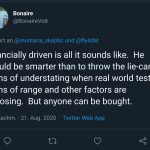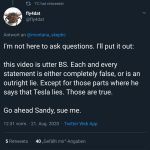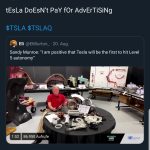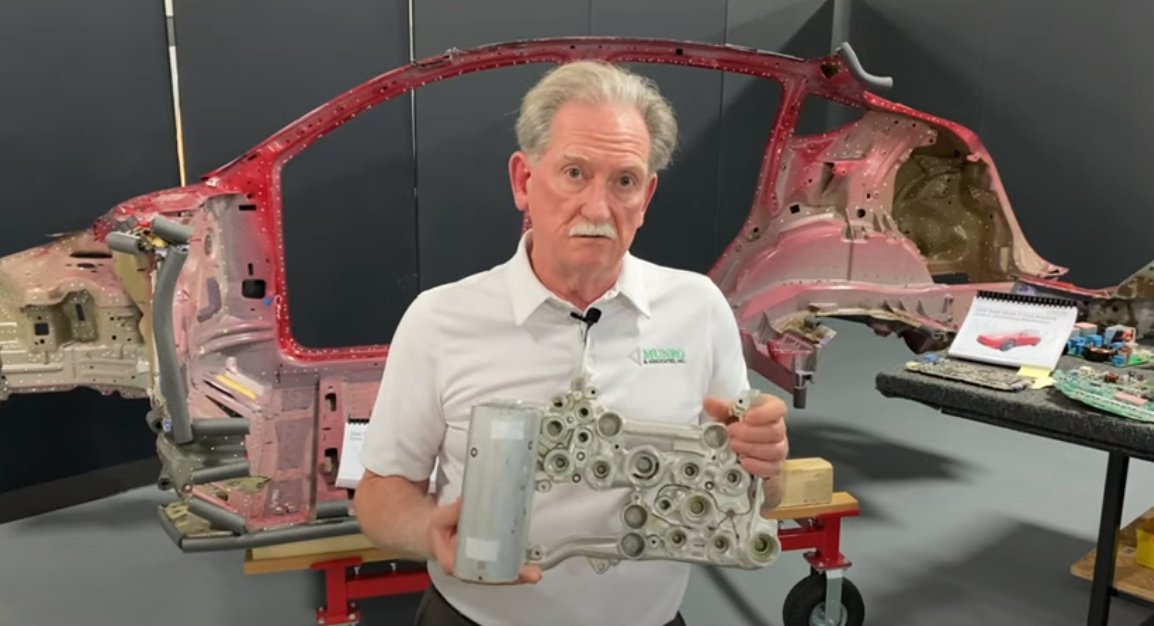
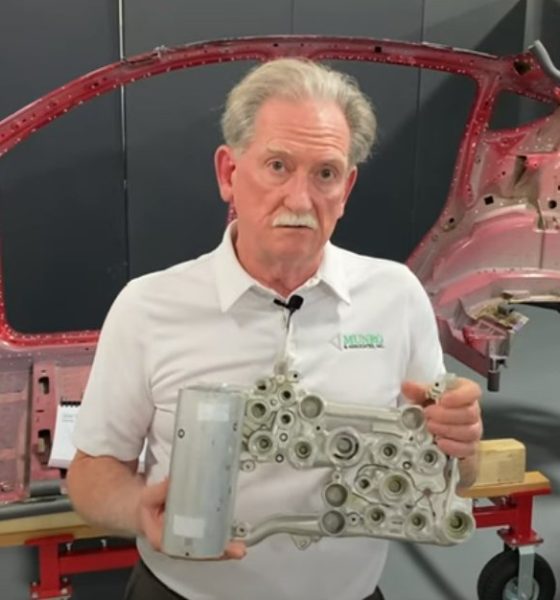
News
Tesla teardown specialist Sandy Munro lays the law on TSLAQ over false allegations
When Sandy Munro started his analysis of an early production Tesla Model 3, he was aghast at the vehicle’s quirks, and he made his disapproval known. Munro did not pull his punches back, pointing out the vehicle’s build quality issues and outlining exactly what was wrong with the all-electric sedan. Yet as soon as his analysis took him beyond the Model 3’s bodywork, Munro found something remarkable: Tesla’s tech was beyond everyone else’s in the automotive industry, and it’s not even close.
By the time he was finished tearing down the Model 3, Munro was already quite impressed with Tesla. Everything, he noted, from the Model 3’s suspension down to its batteries was on point, and the company’s tech was insane. Munro suggested that if Tesla had only paid more attention to its basics like build quality, the electric car maker would have wiped the floor with legacy automakers. These developments could all be reviewed through Munro’s multiple appearances at Autoline After Hours, where he is featured as a guest from time to time.
Munro and his company, Munro and Associates, eventually took on their next Tesla project by tearing down an early production Model Y. The veteran was gracious enough to share his insights on the vehicle through a series that he and his team uploaded on YouTube. The video series documented every step of the Model Y’s teardown process, and while Munro still observed a number of build quality-related points for improvement in the all-electric crossover, he was impressed overall. So impressed, in fact, that Munro opted to share his enthusiasm for the vehicle openly. Recent videos even include “tips” for Tesla that could improve their vehicles further.
#MunroAssociates Tips For #Tesla E3 – Night Vision HUD & Wire Reductionhttps://t.co/WlzodSDwWO pic.twitter.com/5dDEu9LzU9— Munro & Associates (@MunroAssociates) July 25, 2020
This did not sit well with Tesla critics, particularly the online TSLAQ group. Tesla critics and short-sellers are known to propagate the occasional conspiracy theory, whether that involves accusations of abuse by the Tesla CEO to alleged cover-ups by government agencies that are supposedly paid by the electric car maker to do their bidding. Granted, most of these conspiracy theories are just noise, but sometimes, this noise can result in very real repercussions. Unfortunately, this exact thing happened to Sandy Munro.
When it became evident that Munro was openly supportive of Tesla and the Model Y, it did not take long for the TSLAQ Twitter community to insinuate that the teardown expert was actually being paid by the electric car maker for good publicity. Notable short-sellers joined in on the insinuations, TSLAQ trolls dared Munro to file a lawsuit against them, and some members of the media who are known to be critical of the electric car maker brought up the fact that the teardown expert’s stance on Tesla changed over time.
These, of course, neglect to explore one possible explanation for Munro’s shift on his stance about Tesla. While Munro was openly critical of the Model 3 during his first look at the car, he was eventually won over by the tech and innovation that was put into the vehicle. The Model Y, which followed the Model 3, embodied many of Munro’s own points for improvement that he raised during his analysis of the all-electric sedan. Perhaps, just perhaps, Tesla is improving as an automaker, and the company’s electric cars are really in the bleeding edge of automotive tech.
Ever the fighter, Munro has posted a stern response to the insinuations leveled against him by Tesla critics. In a YouTube video, Munro laid down the law on TSLAQ, declaring that neither he nor his company is being paid to talk positively about the electric car maker. And in true Munro fashion, the teardown expert came with evidence, explaining exactly how innovations like the Octovalve are only possible in a company that works like Tesla. Following is his statement.
“Munro and Associates is not, I repeat, is not paid by Tesla to say or do or receive anything that we have. I know that some people are saying things like that. They don’t know what they’re talking about. I have to try and defend myself periodically, and this is it. So, I can tell you a little something right now that the Tesla haters or basically the people that are trying to drive me out of business are saying — that Tesla would never tell you.
“So this is part of the Octovalve. And what we’ve noticed is, we had one of our customers come in with a brand new Tesla. It was built about one month ago and we noticed that their product, the product that you’re seeing here — the aluminum supermanifold — their product had 13 design changes associated with it. Thirteen. I’m going to tell you. I couldn’t get one design change through in a year when I was at Ford Motor Company. They (Tesla) did 13 in three months. That’s why they’re kicking some serious butt.
“Another thing that we found was when we got our vehicle, there was no shroud around the compressor. Their vehicle had an excellent design for a shroud, and it looked spectacular. Now am I saying things that Tesla told me to tell you? I don’t think so… Munro and Associates and myself as the number one associate, we are in this strictly for the right reasons. I am not bought by anyone. No one in this company is bought by anyone. We are a consulting house that tells the truth all the time — good, bad, or ugly — and I’m just starting to find out about this. It’s all crap. Don’t believe any of it.”
Most of the tweets posted online which suggested that Munro was a paid shill for Tesla have already been deleted, though some screenshots of the posts have made the rounds online. It is through these that it was revealed that Sandy Munro has started preparing a lawsuit to hold the TSLAQ members liable for damages, seeing as one of his key clients was affected by the accusations. Based on a message sent by the veteran teardown specialist to a key Tesla critic, it appears that Munro is dead serious, and he is looking to hold those involved in the issue accountable.
Watch Munro’s statement on the allegations in the video below.

News
Tesla FSD fleet is nearing 7 billion total miles, including 2.5 billion city miles
As can be seen on Tesla’s official FSD webpage, vehicles equipped with the system have now navigated over 6.99 billion miles.

Tesla’s Full Self-Driving (Supervised) fleet is closing in on almost 7 billion total miles driven, as per data posted by the company on its official FSD webpage.
These figures hint at the massive scale of data fueling Tesla’s rapid FSD improvements, which have been quite notable as of late.
FSD mileage milestones
As can be seen on Tesla’s official FSD webpage, vehicles equipped with the system have now navigated over 6.99 billion miles. Tesla owner and avid FSD tester Whole Mars Catalog also shared a screenshot indicating that from the nearly 7 billion miles traveled by the FSD fleet, more than 2.5 billion miles were driven inside cities.
City miles are particularly valuable for complex urban scenarios like unprotected turns, pedestrian interactions, and traffic lights. This is also the difference-maker for FSD, as only complex solutions, such as Waymo’s self-driving taxis, operate similarly on inner-city streets. And even then, incidents such as the San Francisco blackouts have proven challenging for sensor-rich vehicles like Waymos.
Tesla’s data edge
Tesla has a number of advantages in the autonomous vehicle sector, one of which is the size of its fleet and the number of vehicles training FSD on real-world roads. Tesla’s nearly 7 billion FSD miles then allow the company to roll out updates that make its vehicles behave like they are being driven by experienced drivers, even if they are operating on their own.
So notable are Tesla’s improvements to FSD that NVIDIA Director of Robotics Jim Fan, after experiencing FSD v14, noted that the system is the first AI that passes what he described as a “Physical Turing Test.”
“Despite knowing exactly how robot learning works, I still find it magical watching the steering wheel turn by itself. First it feels surreal, next it becomes routine. Then, like the smartphone, taking it away actively hurts. This is how humanity gets rewired and glued to god-like technologies,” Fan wrote in a post on X.
News
Tesla starts showing how FSD will change lives in Europe
Local officials tested the system on narrow country roads and were impressed by FSD’s smooth, human-like driving, with some calling the service a game-changer for everyday life in areas that are far from urban centers.

Tesla has launched Europe’s first public shuttle service using Full Self-Driving (Supervised) in the rural Eifelkreis Bitburg-Prüm region of Germany, demonstrating how the technology can restore independence and mobility for people who struggle with limited transport options.
Local officials tested the system on narrow country roads and were impressed by FSD’s smooth, human-like driving, with some calling the service a game-changer for everyday life in areas that are far from urban centers.
Officials see real impact on rural residents
Arzfeld Mayor Johannes Kuhl and District Administrator Andreas Kruppert personally tested the Tesla shuttle service. This allowed them to see just how well FSD navigated winding lanes and rural roads confidently. Kruppert said, “Autonomous driving sounds like science fiction to many, but we simply see here that it works totally well in rural regions too.” Kuhl, for his part, also noted that FSD “feels like a very experienced driver.”
The pilot complements the area’s “Citizen Bus” program, which provides on-demand rides for elderly residents who can no longer drive themselves. Tesla Europe shared a video of a demonstration of the service, highlighting how FSD gives people their freedom back, even in places where public transport is not as prevalent.
What the Ministry for Economic Affairs and Transport says
Rhineland-Palatinate’s Minister Daniela Schmitt supported the project, praising the collaboration that made this “first of its kind in Europe” possible. As per the ministry, the rural rollout for the service shows FSD’s potential beyond major cities, and it delivers tangible benefits like grocery runs, doctor visits, and social connections for isolated residents.
“Reliable and flexible mobility is especially vital in rural areas. With the launch of a shuttle service using self-driving vehicles (FSD supervised) by Tesla in the Eifelkreis Bitburg-Prüm, an innovative pilot project is now getting underway that complements local community bus services. It is the first project of its kind in Europe.
“The result is a real gain for rural mobility: greater accessibility, more flexibility and tangible benefits for everyday life. A strong signal for innovation, cooperation and future-oriented mobility beyond urban centers,” the ministry wrote in a LinkedIn post.
News
Tesla China quietly posts Robotaxi-related job listing
Tesla China is currently seeking a Low Voltage Electrical Engineer to work on circuit board design for the company’s autonomous vehicles.

Tesla has posted a new job listing in Shanghai explicitly tied to its Robotaxi program, fueling speculation that the company is preparing to launch its dedicated autonomous ride-hailing service in China.
As noted in the listing, Tesla China is currently seeking a Low Voltage Electrical Engineer to work on circuit board design for the company’s autonomous vehicles.
Robotaxi-specific role
The listing, which was shared on social media platform X by industry watcher @tslaming, suggested that Tesla China is looking to fill the role urgently. The job listing itself specifically mentions that the person hired for the role will be working on the Low Voltage Hardware team, which would design the circuit boards that would serve as the nervous system of the Robotaxi.
Key tasks for the role, as indicated in the job listing, include collaboration with PCB layout, firmware, mechanical, program management, and validation teams, among other responsibilities. The role is based in Shanghai.
China Robotaxi launch
China represents a massive potential market for robotaxis, with its dense urban centers and supportive policies in select cities. Tesla has limited permission to roll out FSD in the country, though despite this, its vehicles have been hailed as among the best in the market when it comes to autonomous features. So far, at least, it appears that China supports Tesla’s FSD and Robotaxi rollout.
This was hinted at in November, when Tesla brought the Cybercab to the 8th China International Import Expo (CIIE) in Shanghai, marking the first time that the autonomous two-seater was brought to the Asia-Pacific region. The vehicle, despite not having a release date in China, received a significant amount of interest among the event’s attendees.
